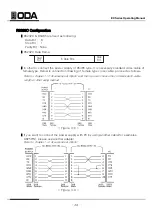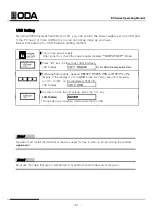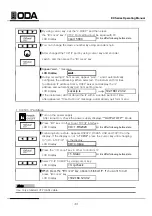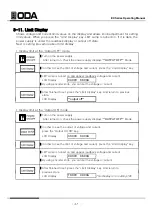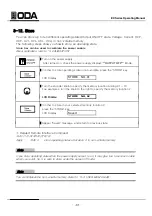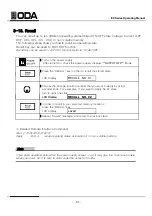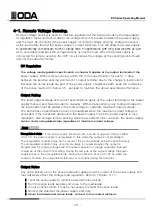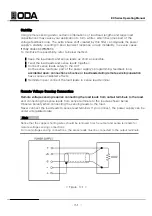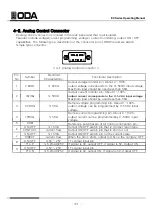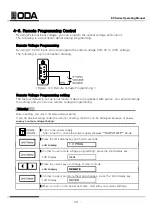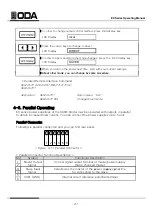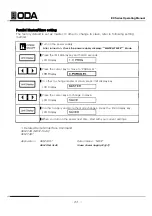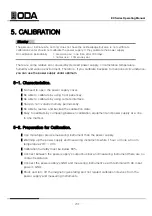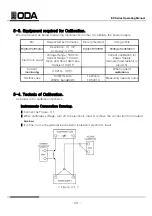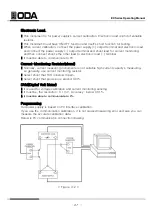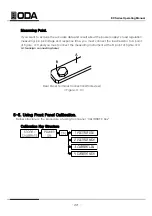
EX Series Operating Manual
4-1. Remote Voltage Sensing.
Remote voltage sensing is used to maintain regulation at the load and reduce the degradation
of regulation that would occur due to the voltage drop in the leads between the power supply
and the load. By connecting the power supply for remote voltage sensing, voltage is sensed
at the load rather than at the power supply’s output terminals. This will allow the power supply
to automatically compensate for the voltage drop in applications with long lead lengths as well
to automatically compensate for the voltage drop in applications with long lead lengths as well
as to accurately read back the voltage directly across the load. When the power supply is
connected for remote sensing, the OVP circuit senses the voltage at the sensing points (load)
and not the output terminals.
CV Regulation
The voltage load regulation specification in chapter 8 applies at the output terminals of the
The voltage load regulation specification in chapter 8 applies at the output terminals of the
power supply. When remote sensing, add 5 mV to this specification for each 1 V drop
between the positive sensing point and (+) output terminal due to the change in load current.
Because the sense leads are part of the power supply’s feedback path, keep the resistance
of the sense leads at or below 0.5 per lead to maintain the above specified performance.
Output Rating
The rated output voltage and current specifications apply at the output terminals of the power
supply that you purchased product's capacity. With remote sensing, any voltage dropped in
the load leads must be added to the load voltage to calculate maximum output voltage.
The performance specifications are not guaranteed when the maximum output voltage is
exceeded. If the excessive demand on the power supply forces the power supply to lose
regulation. Also voltage remote sensing value is exceeded 1V per one wire, the power supply
can be under unregulated state regardless of maximum output voltage
can be under unregulated state regardless of maximum output voltage.
Unregulated state? If the power supply should go into a mode of operation that is neither
CV or CC, the power supply is unregulated. In this mode the output is not predictable.
The unregulated condition may be the result of the ac line voltage below the specifications.
The unregulated condition may occur momentarily. For example when the output is
Note
programmed for a large voltage step; the output capacitor or a large capacitive load will
charge up at the current limit setting. During the ramp up of the output voltage the power
supply will be in the unregulated mode. During the transition from CV to CC as when the
output is shorted, the unregulated state may occur briefly during the transition.
Output Noise
Any noise picked up on the sense leads also appears at the output of the power supply and
may adversely affect the voltage load regulation. Refer to <Figure. 3-1>.
▌Twist the sense leads to minimize external noise pickup.
▌Run the sense leads parallel and close to the load leads.
▌In noisy environments it may be necessary to shield the sense leads.
▌Ground the shield at the power supply end only.
▌About load leads and sense leads connect in the nearest distance
▌About load leads and sense leads, connect in the nearest distance.
- 53 -
Содержание EX Series
Страница 2: ......
Страница 104: ...EX Series Operating Manual 104...
Страница 105: ...EX Series Operating Manual 105...
Страница 107: ...EX Series Operating Manual 2U 2 6KW 5KW Product Outside Dimension 2U 2 6KW 5KW Product Rear Feature 107...
Страница 108: ...EX Series Operating Manual 4U 5 1KW 10KW Product Outside Dimension 4U 5 1KW 10KW Product Rear Feature 108...
Страница 113: ...EX Series Operating Manual Reliability Durability Life time Test System Solution 113...

